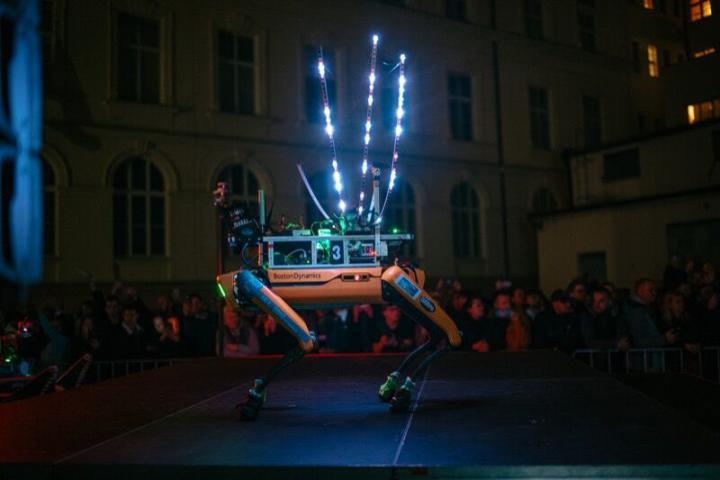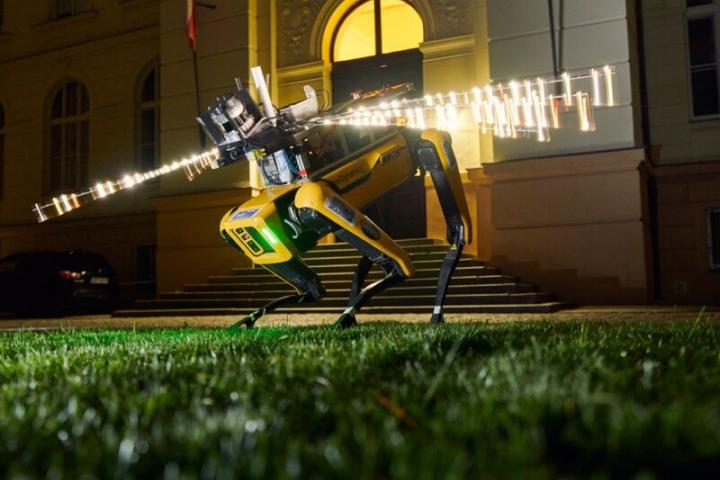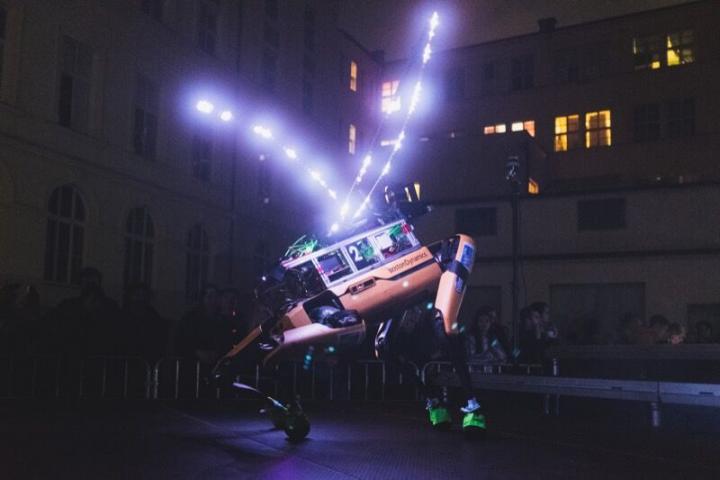
For the first time, the Faculty of Electrical Engineering of the Czech Technical University with the Forum Robotum installation also participated. During the four visiting days, it attracted an incredible 24,000 people of all ages, making the event one of the largest popularization activities of the faculty in recent years. Clearly, the shared future of humans and robots is a topic that is moving society!
Video of the installation - https://youtu.be/65mZvCxGylU.
The realm of robotic animals
hat could visitors experience? A team of scientists, students and an external designer transformed the campus courtyard on Charles Square into a robotic zoo. Four types of research robots paraded around elevated platforms and showed what they could do. For the purposes of the installation, the robots were augmented with LED exoskeletons whose colourful transformation was used to interact with visitors. The luminous organs resembled the shape of insect trunks, buds, peacock tails or butterfly wings. And it's no coincidence! In fact, the anatomy and movement of some of the robots (e.g. the six-legged spider or the robotic dog) are derived from real animals, and so these elements also found inspiration in nature.
"But unlike real animals, robots are still just machines, so they had trouble adapting to the change in their environment," recalls robot pack coordinator Bedřich Himmel. "As the evening progressed, fog fell and the stage began to shine like a mirror(at least for some sensors) and slide. Therefore, we had to equip the four-legged robots with special grippers made of non-slip gloves and adjust the parameters of the control algorithms," Himmel explains how they dealt with the unexpected challenges on site.
The world as robots see it
A depth map of the space was projected on a large screen, which the robots created using lidars (laser distance meters). In real time, the audience could see how the machines see the world around them, including us.
This map also mediated the interaction with the audience. There were virtual cubes of different colours in the space and the increased movement in each part sent the appropriate colour signal to the robots. People waved at the robots, lifted their children onto their shoulders or danced to the instructional animation on the screen. The transformation of the lighting elements on the robots always cheered up everyone watching (especially when all the robots turned bright red at once), and also provided a demonstration of what the robots' response to our presence might look like.
Attend to the electromagnetic field
Everyone has probably seen a robot at some point, whether it's a simple toy, industrial machine or experimental system for research. But have you ever heard what such a robot sounds like? It's not exactly common! So we decided to convert the electromagnetic field of robots into a soundtrack using a pickup from a guitar. This was then harmonised, so that the whole space was filled with magical music reminiscent of a sci-fi movie soundtrack. And we also attached sensors directly to the SPOT robot dogs, which emitted dark tones when they moved.
The talented PhD student Vojtěch Leischner from the Department of Computer Graphics and Interaction is behind this complex audio experience. "It wasn't without a lot of emails and consultations, but it was more fun than I expected! I made new friends, I found out that even robots are slippery and need half-wet gloves, and I tried a ride on the installation curator's electric unicycle. If I had to decide again, I would definitely do it again!"
Student Inessa Davtyan, who together with other students of the faculty formed an indispensable team of operators, also sees her involvement in the project as a positive experience.
"It was very cool! Thanks to the caring organizers, we had a good time working and I quickly learned to use the robot. I'll never forget how the visitors cheered for Charlie the robot as he walked up the stairs," Inessa recalls the fun times at the festival.
The students controlled the robots remotely to ensure the event ran safely and also to show the robots at their best with a full range of motion. After all, a SPOT can dance and obey on command!
A complex organism of lights, robots, sensors and algorithms
The biggest challenge for the team was to integrate all the elements of the installation into one working whole. In addition to the robots themselves, this consists of electromagnetic sensors, microcontrollers, several wireless modules, light control, lidar, and data analysis to mediate the interaction between humans and robots.
"Today's technologies are really very complex. What appears to be a simple thing at first glance has many different systems, buses and protocols in the background. Connecting them was key to creating such an installation - yet it is an invisible and often challenging job for researchers," says Jiří Zemánek, curator of the installation from the Department of Control Engineering, of the daunting task. But the hard work has clearly paid off. "I also really enjoyed the atmosphere of the installation, which some visitors described as being from another world," he adds.


